Comme ça a été dit des centaines de fois. Le projet a des qualités. Il suscite aussi des questions légitimes, et des interrogations sur ses impacts.
Critiquer un projet ne veut pas dire le rejeter complètement.
Comme ça a été dit des centaines de fois. Le projet a des qualités. Il suscite aussi des questions légitimes, et des interrogations sur ses impacts.
Critiquer un projet ne veut pas dire le rejeter complètement.
Si les gens sont contre la structure aérienne du REM de l’Est au centre-ville, c’est qu’ils rejettent le projet de transport en commun rapide de la Caisse. Les forumeurs d’ici ont beau prier pour un tunnel sous le centre-ville, mais rien n’indique que cela peut se concrétiser.
Le problème est là. Ce que tu dis, c’est que c’est tout ou rien: soit on accepte la structure aérienne, soit il n’y a pas de REM de l’Est.
Depuis quand est-ce qu’on devrait accepter sans réserve des projets déjà ficelés et élaborés derrière des portes closes par un organisme qui n’a pas de comptes à rendre? Il s’agit, selon moi, d’un précédent inquiétant.
C’est exactement ça. Le REM de l’Est ou rien (pour l’instant). Cela dépendra après les consultations publiques.
J’ai trouvé ceci sur le site web de la CDPQi, soit les explications que les six scénarios de tunnel au centre-ville ont été rejetés.
Oui je l’ai lu il y a longtemps. Je comprends les enjeux.
Ce que je dis, c’est que ça n’a pas de bon sens qu’on ait à faire un tel choix (REM ou rien).
Il reste le tramway sur René-Lévesque, sauf qu’aucun projet de (nouveau) tramway n’a vu le jour à Montréal jusqu’à présent. Et cela risque d’être un projet encore plus complexe si on commence à vouloir que le tramway soit également en tunnel et en aérien sur certains tronçons du tracé.
Avec respect, je ne vois pas le rapport avec le tramway?
Si on ne peut pas faire de tunnel au centre-ville dû aux risques d’affaisement du sol, le tramway serait une option qui n’a pas été explorée encore.
Qu’on arrête avec l’affaissement comme raison problématique. C’est un enjeu financier, pas technique. On continue de construire des tours de plus en plus hautes et larges dans tout le secteur, exerçant une pression de plus en plus grande sur le sol soit-disant extrêmement meuble; sans souci. La nouvelle super tour de 62 étages de Canvar sur Saint-Jacques est littéralement entourée de structures routières souterraines + la structure du viaduc ferroviaire.
Je veux bien admettre que c’est un sous-sol dense et qui travaille déjà beaucoup, mais ça n’empêche pas d’installer un tunnel de train léger en profondeur et loin des fondations des bâtiments supposément à risque. Ce sont des histoires de $$$.
Je veux voir les rapports d’expertise, pas des résumés à la sauce CDPQi, avant de me corriger là-dessus.
Qu’est-ce qui fait que tu sois 100% certain qu’un tunnel est possible au centre-ville? Es-tu arpenteur-géomètre?
Je suis ingénieur en métrologie dimensionnelle, en génie civil, mécanique et automatisation.
Qu’est-ce qui te fait dire que ce n’est pas possible?
Encore une fois, et j’ai l’impression de radoter sur le thread, il y a des projets ferroviaires souterrains bien plus complexes dans le monde qui ont été et qui sont en cours de réalisation. Croire que Montréal est une exception à la règle est tout à fait possible; mais je tiens à voir les études réalisées avant de le tenir pour acquis. Mon esprit critique me laisse songer que ce qui est réalisé en ce moment à Paris, New-York, Londres & Frankfort; d’un degré de complexité qui m’apparaît autrement plus poussé que de creuser en ligne droite sous un large boulevard; prouve que c’est possible techniquement d’enterrer un train léger à Montréal. Ce serait peut-être complexe, mais on a soit-disant un génie incroyable au Québec et ce serait un moyen de l’exposer.
Je ne suis pas un expert pour les details; mais je reste pantois quant au “centre-ville qui s’effondrerait” car on creuserait un tunnel pour un train. Dites que c’est cher; pas que c’est un danger réel et insurmontable.
Je pense qu’ils ont raison de dire que le sol est meuble. Ce sont principalement des dépots lacustres de sable et silt (sable fin), pas très stables. Toutefois, les dépots ne sont pas trop épais (environ 50pi). La roche en dessous, si je ne me trompe pas, c’est du calcaire, donc pas idéal, mais je trouve moi aussi que de parler d’affaissement de gratte-ciels, c’est une conclusion facile et peu poussée.
D’après ce que j’ai entendu et lu sur le web, cela avait l’air d’être irréalisable, mais bon si tu le dis, j’imagine que c’est faisable.
Si le coût de construction exorbitant est la principale raison de ce refus de creuser, peut-être que la Caisse a raison après tout. Terminer avec un projet qui coûte les yeux de la tête et n’est pas avantageux pour tout le monde, autant les investisseurs que le gouvernement et les contribuables.
Je ne veux pas paraitre sortir un argument d’autorité haha, je ne suis pas un spécialiste en géotechnie.
Je suis d’accord avec toi: si c’est trop cher et/ou trop compliqué, qu’on l’avoue et c’est très bien comme tel; mais qu’on ne sorte pas des arguments qui font peur comme un effondrement des bâtiments mitoyens au tunnel. Ca me paraît de très mauvaise foi, et utilisé pour justifier qu’on ne veuille pas y mettre plus de $$$ que nécessaire par CDPQi.
De ce que je lis, on est entre du 50 pieds au niveau du Pont Jacques Cartier et 30 au niveau de Robert-Bourassa. D’ailleurs ca serait un des endroits avec le moins de dépôts meubles du CV. Tout ce qui est autour du Square Victoria est entre 50 et 70 pieds. Les tours du Square Children sont dans du 50 à 70 pieds. La 720 (et le tronçon de la ligne orange du coin) a été creusée dans du 40 à 80+ pieds de dépôts meubles à l’Est de Bourassa.
BREF.
EDIT ajout de la cartographie Drift-Thickness Countours:
En même temps, pourquoi est-ce qu’on devrait accepter un projet moins cher, mais avec plus d’externalités négatives?
C’est au gouvernement d’assumer la facture. La Caisse a le droit de ne pas vouloir investir plus pour un tunnel. Leur réflexion est financière. C’est correct qu’ils disent non parce que construire en tunnel enlèverait toute possibilité au projet d’être rentable.
Le gouvernement par contre, n’a pas à avoir ce souci de rentabilité. Son analyse doit se concentrer sur toutes les externalités qu’on ne regarde pas quand on fait une analyse comptable ou financière. Impact sur les populations, impact sur les retombées macro, acceptabilité sociale, etc. La conclusion pourrait être de ne pas construire, c’est correct, mais on a le droit d’avoir une telle analyse du projet avant d’accepter qu’on nous bâtisse une cicatrice urbaine en plein centre-ville.
Jonathan Montpetit · CBC News · Posted: Mar 22, 2021 4:00 AM ET | Last Updated: 1 hour ago
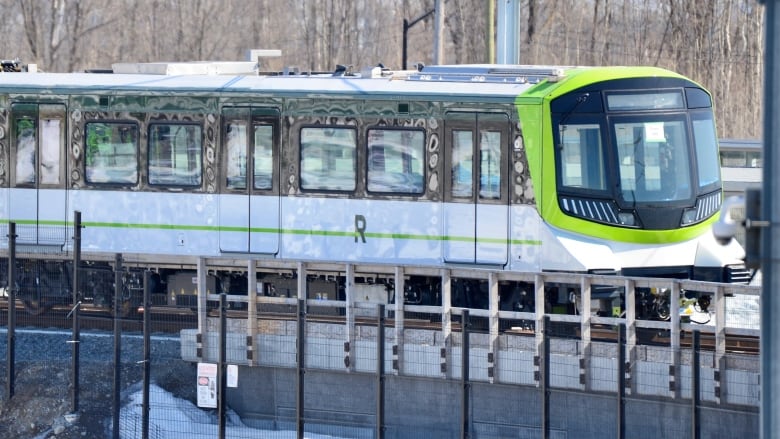
A “light rail” car on a test run south of Montreal. The first section of the REM network is scheduled to be operational next year. (Jean-Claude Taliana/CBC)
When Quebec’s pension fund manager announced in 2016 that it was going to build a state-of-the-art, 67-kilometre “light rail” network around Montreal, it seemed like a miracle solution for the city’s cash-starved transit system.
It had been decades since the last major investment in Montreal public transit. The Caisse de dépôt et placement du Québec appeared out of nowhere, offering to shoulder most of the up-front costs for connecting the western half of the metropolitan area to downtown.
In exchange, it would get the revenues generated from operating the network.
“It’s probably one of the greatest projects we’ve seen in [public transit] in the last 50 years,” gushed the mayor at the time, Denis Coderre.
Late last year, the Caisse announced it was expanding its “light rail” network, now dubbed the REM, into Montreal’s east end. But the reception, this time, was decidedly less enthusiastic.
Architects and urban planners have publicly criticized the plans. Neighbourhood groups are lobbying for changes. A petition has attracted nearly 2,000 signatures. Even city hall has expressed reservations.
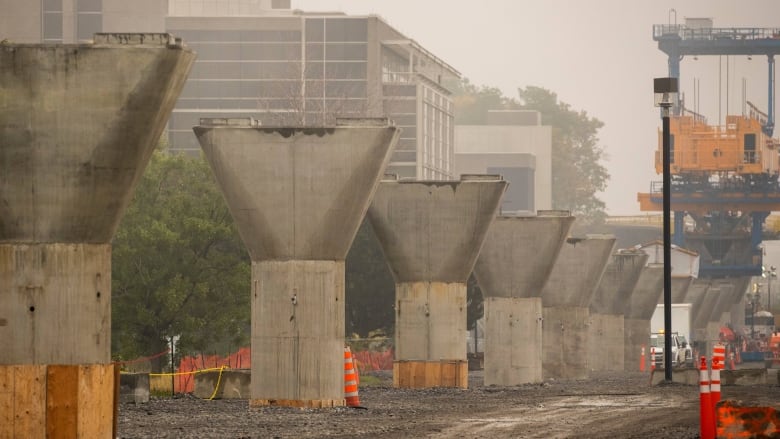
The REM will run for long stretches along an elevated track supported by massive concrete columns. These are being built in Montreal West Island. (Ivanoh Demers/Radio-Canada)
They all share concerns about the current design plan for the project, which features an elevated track supported by massive concrete pillars running through some of the most densely populated areas of the island of Montreal.
“We’re scared about what will happen to our neighbourhoods with this immense structure,” said Catherine Miron, a spokesperson for a group of concerned east-end residents called REM et citoyen-nes de l’Est de Montréal.
CDPQ Infra, the arm of the Caisse that oversees the REM, maintains the elevated track is the only way the east-end network can be built on time and on budget.
Those are important considerations for the provincial government, which campaigned on a promise to connect the island’s east-end suburbs to downtown.
And, so far, CDPQ Infra has proved its alternative model for funding infrastructure can deliver. While other transit projects backed by municipal governments and transit authorities have stalled on the drawing board for years, the west-end REM is nearing completion and in the ballpark of its original budget.
But it sped ahead with only marginal input from independent experts and citizens, say observers of the process. They fear a similar dynamic is emerging as the REM expands east, leading to a project that will scar neighbourhoods in the interest of profit and politics.
“It might not be the right mode of transit in the right place,” said François Pepin, president of the public transit advocacy group Trajectoire Québec.
There is not much debate that the east end of Montreal needs better transit connections with downtown Montreal. Much of that territory only has bus service, which is usually crowded and slow during rush hour.
In May 2019, the Coalition Avenir Québec government asked CDPQ Infra, as opposed to the co-ordinating transit authority for the Montreal area (known by its French initials as ARTM), to look at meeting that demand.
That CDPQ Infra ended up proposing a “light rail” network was no surprise. It’s the only transit technology it has on offer, though transit experts have in the past suggested other solutions for the east end, such as bus-rapid transit or tramways.
The elevated track being built in Montreal’s West Island runs along highways, and hasn’t stirred much public concern. But in the east end, large stretches of the REM network would run along boulevards in mixed residential-commercial neighbourhoods.
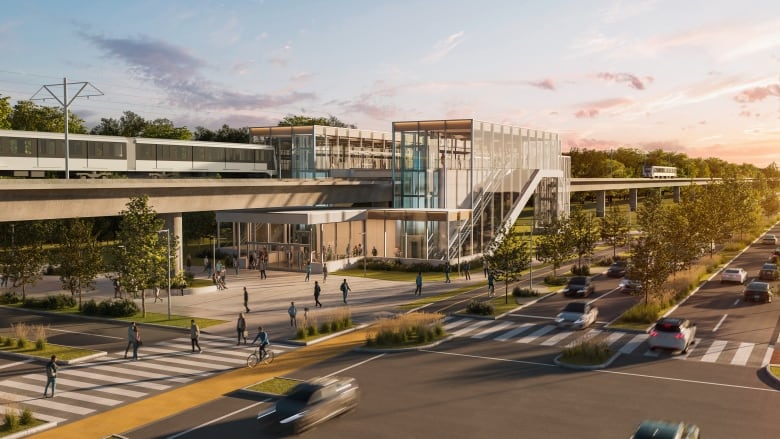
An artist’s conception of the type of REM station that will be built on Notre-Dame Street. (Caisse de dépôt et placement du Québec)
As well, the prospect of noise, shadows, and a lot of concrete has urban planners worried.
“It’s a big structure going through areas where people live. It risks destroying their quality of life,” said Sylvain Gariépy, president of the Quebec Order of Urban Planners.
Gariépy expressed frustration at the lack of detailed information CDPQ Infra has provided about the proposed structures, making it difficult to evaluate the project.
Citizen groups have also struggled to get more information about the project, and to offer their feedback. Miron said she has attended two meetings with CDPQ Infra in recent weeks, but they resembled marketing sessions rather than consultations.
“They gave the same PowerPoint presentation at both of them and couldn’t answer our technical questions,” Miron said.
CDPQ Infra stresses the proposal it has made public is a work in progress. It is promising to spend the next two years consulting extensively with the public as well as an independent group of experts.
Virginie Cousineau, the organization’s public affairs director, said consultations will play a larger role in the final design of the REM’s extension compared with the consultations that were done ahead of the first phase of the project.
“There are things we’re doing differently in the REM East, things we didn’t do in the REM 1.0,” Cousineau said in a recent interview.
But she also acknowledged that certain elements of the project are non-negotiable. Many have called for the track to go underground as it approaches downtown. Cousineau said while that option was studied, existing subway lines and old sewers threaten to escalate costs to prohibitive levels.
“The Caisse can’t endanger the pensions of Quebecers with a project where we are unable to control the risks,” she said.
The concerns about the REM’s east-end extension are not just technical matters about an engineering project, however. They are part of a larger debate about which institutions ought to be shaping the future of Quebec’s cities.
Provincial funding for Quebec City’s tramway project was held up when the CAQ government began demanding last-minute changes to the route, even though it had been the subject of extensive consultation since 2018 and had widespread local backing.
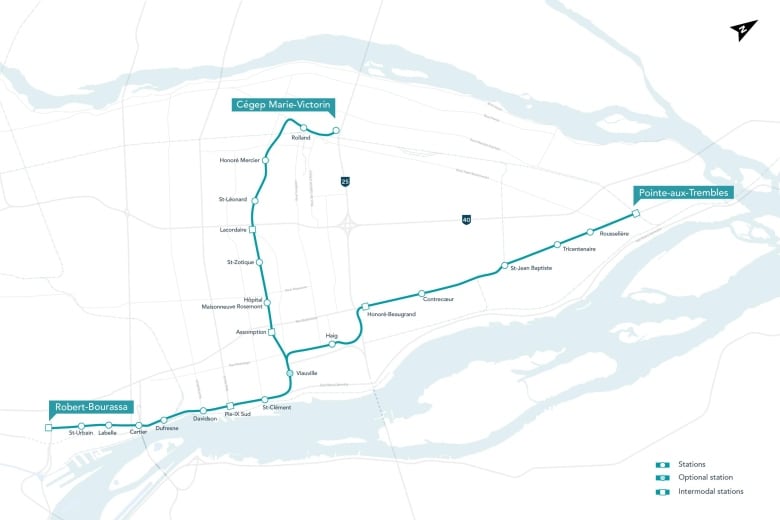
The REM’s proposed east-end extension would reach parts of Montreal that have long been underserved by public transit, allowing residents to reach downtown faster than by car or bus. (Submitted by CDPQ Infra)
Premier François Legault said the project needed to better serve the suburbs in order to get his government’s approval. Community groups in Quebec City, and the mayor, accused him of meddling for political gain.
In the case of both the Quebec City tramway, and the REM in Montreal, local transit authorities seemed to be sidelined at key stages of the decision-making process.
That’s a shame, said Pepin, given that transit authorities, like the ARTM, were created with the intention of limiting the influence of politicians on major projects and making public consultation routine.
They are meant to be relatively independent bodies that have the expertise required to plan a transit network with the interests of the public in mind.
“It’s a science,” Pepin said of public transit planning. “We talk about it for the vaccine; maybe we should do the same thing for public transit and listen to the science.”
Transit authorities, though, often operate too slowly for politicians. That makes alternative funding models that can fast-track projects, like CDPQ Infra, appealing.
“The idea, of course, is to get a project shovel-ready before the next election,” said Pierre Barrieau, president of Gris Orange, a Montreal-based urban transit consulting firm.
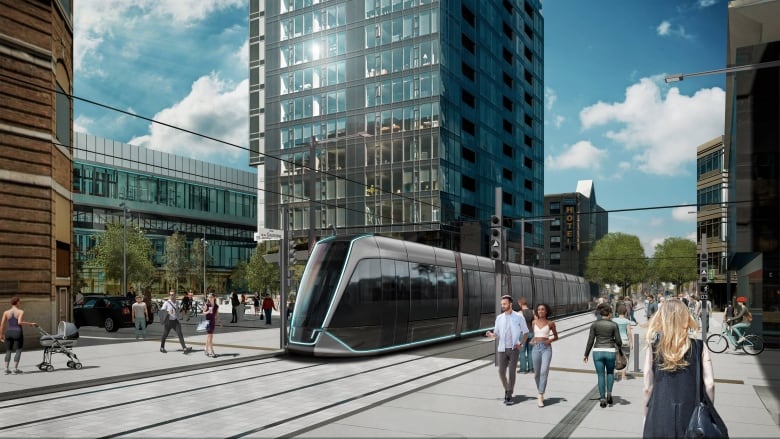
Mayor Régis Labeaume says many elements already included in Quebec City’s tramway project won’t need to be revised. (Ville de Québec)
At the same time, community groups in Montreal have adapted to CDPQ Infra’s pace.
They learned from the first phase of the REM, Barrieau said, and are mobilizing at the outset of the second phase to demand more input.
“We should expect a project that will take comments from the public into greater consideration,” he said. “I think the Caisse understands that what they did for the first time isn’t going to fly for the second time.”
“Light rail” 


Bien qu’on le définit comme un mode de transport de type métro léger en français, il semblerait que sa traduction soit bien “light rail”… mais quelque fois “light metro (medium-capacity rail system)”.
Bref, c’est plutôt confondant ! ![]()